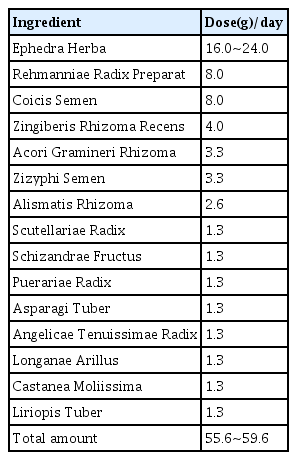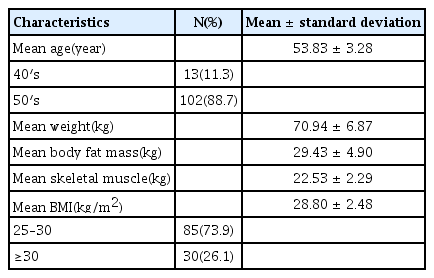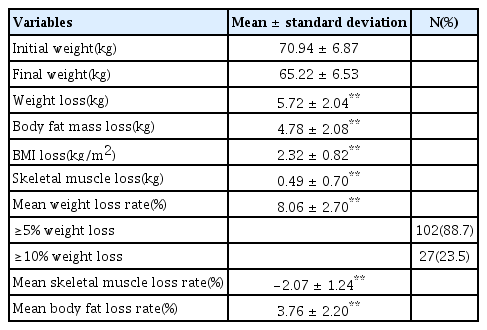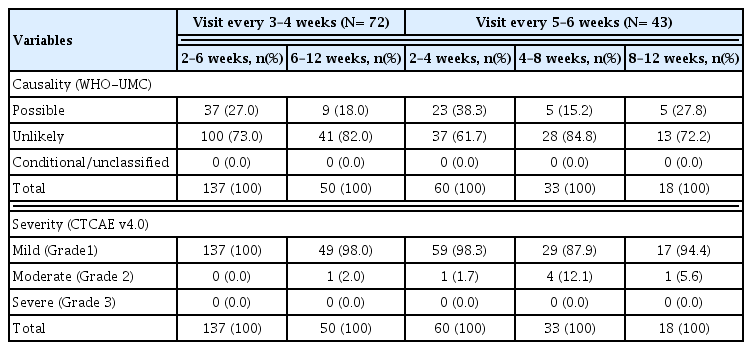References
2. Park JH, Yoon SJ, Lee H, Jo HS, Lee SI, Kim Y, et al. Burden of disease attributable to obesity and overweight in korea. Int J Obes 2006;30(11):1661–1669.
https://doi.org/10.1038/sj.ijo.0803321.
3. World Health Organization. The Asia-Pacific Perspective: Redefining obesity and its treatment 2000;
4. Haam JH, Kim BT, Kim EM, Kwon H, Kang JH, Park JH, et al. Diagnosis of obesity: 2022 update of clinical practice guidelines for obesity by the korean society for the study of obesity. J Obes Metab Syndr 2023;32(2):121.
https://doi.org/10.7570/jomes23031.
6. Eckel RH. Obesity: Mechanisms and clinical management USA: Lippincott Williams & Wilkins; 2003. p. 3–102.
7. World Health Organization. Report of a WHO scientific group: Research on the menopause WHO Technical Report Series. 1981. 670p. 8–12.
8. Poehlman ET, Goran MI, Gardner AW, Ades PA, Arciero PJ, Katzman-Rooks SM, et al. Determinants of decline in resting metabolic rate in aging females. Am J Physiol 1993;264(3):E450–E455.
https://doi.org/10.1152/ajpendo.1993.264.3.E450.
9. Yun YS. Obesity in women: Effect of pregnancy and menopause. J Korean Acad Fam Med 2002;23(5):553–564.
10. Kanai H, Matsuzawa Y, Kotani K, Keno Y, Kobatake T, Nagai Y, et al. Close correlation of intra-abdominal fat accumulation to hypertension in obese women. Hypertension 1990;16(5):484–490.
https://doi.org/10.1161/01.HYP.16.5.484.
11. Barrett-Connor E. Epidemiology and the menopause: A global overview. Int J Fertile 1993;38:6–14.
13. Dupuit M, Maillard F, Pereira B, Marquezi ML, Lancha AH Jr, Boisseau N. Effect of high intensity interval training on body composition in women before and after menopause: A meta-analysis. Exp Physiol 2020;105(9):1470–1490.
https://doi.org/10.1113/EP088654.
14. Cho HS, Seo YH, Kim KW, Cho JH, Song MY. The retrospective analysis of effects of h gambitang (gb-001) on weight loss in pre-and post-menopausal obese woman. J Korean Med Obes Res 2020;20(1):20–30.
https://doi.org/10.15429/jkomor.2020.20.1.20.
15. Wang ST, Lin YK, Weng SF, Huang CL, Huang HC, Chiu YC, et al. Skeletal Muscle Ratio: A Complete Mediator of Physical Activity and HbA1C in Type 2 Diabetes. Biol Res Nurs 2020;22(4):534–543.
https://doi.org/10.1177/109980042094288.
16. Korean Obesity Association. Treatment Guideline for Obesity 2018;:17–18.
17. Korea Institute of Drug Safety & Risk Management. Adverse drug assessment report 1st edth ed. Seoul: Korea Institute of Drug Safety & Risk Management; 2013. p. 60–63.
18. National Cancer Institute. National Institute of Health, U.S. Department of Health and Human Services. Common Terminology Criteria for Adverse Events (CTCAE) Version 4.0 2010.
19. Korea Institute of Drug Safety & Risk Management. Terminology guide for reporting adverse drug reactions Seoul: Korea Institue of Drug Safety & Risk Management; 2014. p. 1–6.
20. Lee JM. Longevity and life preservation in Eastern medicine Seoul: Haklimsa; 1986. p. 333–338.
21. Lee HR, Oh HJ, Lee JY, Lee JH. A systematic review and meta-analysis on constitutional herbal medicine treatment for obesity. J Sasang Constitut Med 2022;34(2):36–47.
https://doi.org/10.7730/JSCM.2022.34.2.36.
23. Yoon NR, Yoo YJ, Kim MJ, Kim SY, Lim YW, Lim HH, et al. Analysis of adverse events in weight loss program in combination with ‘
gamitaeeumjowee-tang’and low-calorie diet. J Korean Med Obes Res 2018;18(1):1–9.
https://doi.org/10.15429/jkomor.2018.18.1.1.
24. Jang IS, Yang CS, Hwang EH. The need for clinical practice guidelines in usage of mahuang in weight loss. J Korean Med Obes Res 2007;7(1):23–29.
25. Soh MG, Song YK, Lim HH. A literature review on obesity in elderly. J Korean Med Obes Res 2006;6(2):51–58.
26. Choi JK. Obesity defined by body mass index and metabolic status in the elderly. J Korean Geriatr Soc 2011;15(4):222–229.
27. Lee SS, Choi HJ. The relationship between perception of old age and social participation of older adults. J Soc Sci Res 2019;30(2):181–198.
10.16881/jss.2019.04.30.2.181.
28. Jeong H, Lee C, Han SY, Ko YJ, Kim KJ. Relationship between anemia with frailty and nutritional intake in persons age 65 and older: The 2016–2018 korea national health and nutrition examination survey. Korean J Fam Pract 2023;13(1):15–22.
https://doi.org/10.21215/kjfp.2023.13.1.15.
29. Yang MS, Shin MS, An HL. A literature review on obesity in postmenopausal women. J Korean Med Obes Res 2008;8(2):1–13.
30. Fabricatore AN, Wadden TA, Moore RH, Butryn ML, Heymsfield SB, Nguyen AM. Predictors of attrition and weight loss success: Results from a randomized controlled trial. Behav Res Ther 2009;47(8):685–691.
https://doi.org/10.1016/j.brat.2009.05.004.
31. Hadžiabdić MO, Mucalo I, Hrabač P, Matić T, Rahelić D, Božikov V. Factors predictive of drop-out and weight loss success in weight management of obese patients. J Hum Nutr Diet 2015;28(2):24–32.
https://doi.org/10.1111/jhn.12270.
32. Batterham Marijka Tapsell L, Charlton K, O’shea J, Thorne R. Using data mining to predict success in a weight loss trial. J Hum Nutr Diet 2017;30(4):471–478.
https://doi.org/10.1111/jhn.12448.
35. Annesi JJ, Whitaker AC. Psychological factors associated with weight loss in obese and severely obese women in a behavioral physical activity intervention. Heal Educ Behav 2010;37(4):593–606.
https://doi.org/10.1177/109019810933167.
36. Annesi JJ, Whitaker AC. Psychological factors discriminating between successful and unsuccessful weight loss in a behavioral exercise and nutrition education treatment. Int J Behav Med 2010;17(3):168–175.
10.1007/s12529-009-9056-2.
37. Lee EJ, Park YB, Lim YW, Kim SY. The association between sleep and weight loss among adult women with obesity administered with
gamitaeeumjowee-tang
. J Korean Med 2020;41(3):22–31.
https://doi.org/10.13048/jkm.20023.
38. Lee AR, Lee DY, Kim MJ, Lee HS, Choi KH, Kim SY, et al.
Gamitaeeumjowee-tang for weight loss in diabetic patients: A retrospective chart review. J Korean Med 2021;42(1):46–58.
https://doi.org/10.13048/jkm.21004.
39. Park MJ, Kim EJ, Ok JM, Choi KH, Lim YW.
Gamitaeeumjowee-tang for weight loss in overweight and obese women with polycystic ovary syndrome: A retrospective chart review. J Korean Med Obes Res 2022;22(2):136–146.
https://doi.org/10.15429/jkomor.2022.22.2.136.
40. Proserpio P, Marra S, Campana C, Agostoni EC, Palagini L, Nobili L, et al. Insomnia and menopause: A narrative review on mechanisms and treatments. Climacteric 2020;23(6):539–549.
https://doi.org/10.1080/13697137.2020.1799973.
41. Kim E, Park YB, Choi K, Lim YW, Ok JM, Noh EY, et al. Application of machine learning to predict weight loss in overweight, and obese patients on korean medicine weight management program. J Korean Med 2020;41(2):58–79.
https://doi.org/10.13048/jkm.20015.








